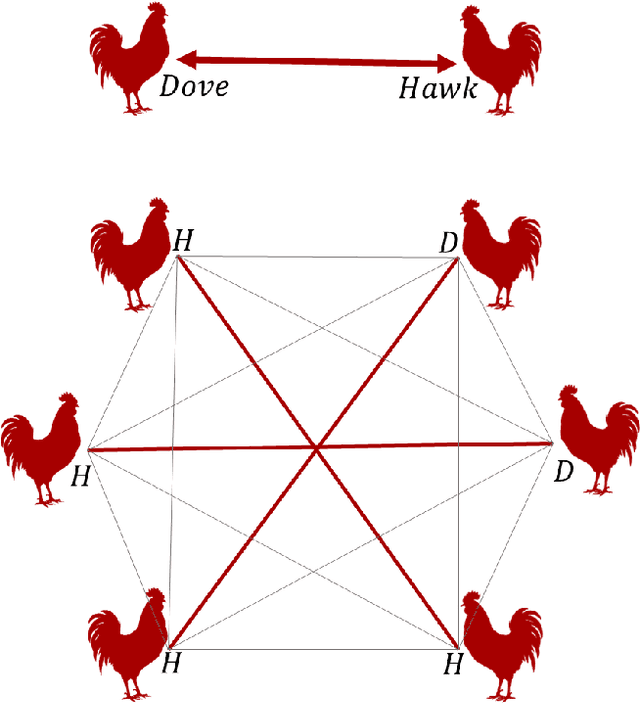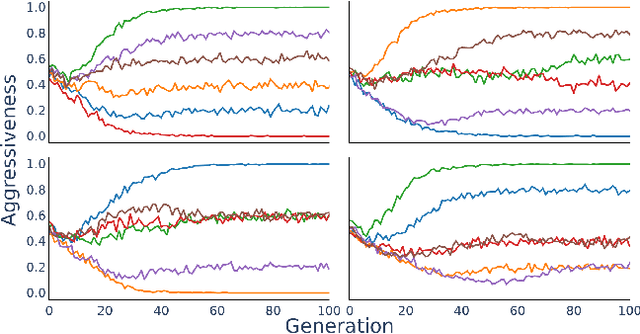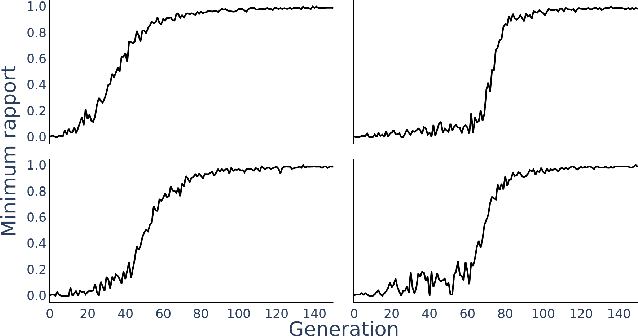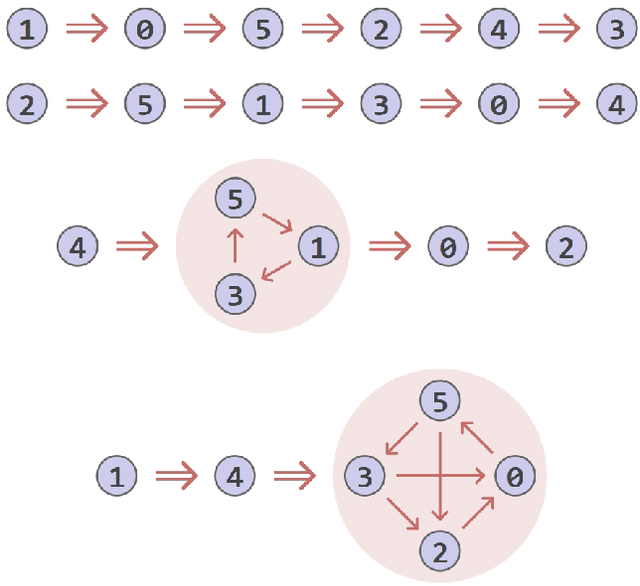Bill Tomlinson
Emergent Dominance Hierarchies in Reinforcement Learning Agents
Feb 01, 2024



Abstract:Modern Reinforcement Learning (RL) algorithms are able to outperform humans in a wide variety of tasks. Multi-agent reinforcement learning (MARL) settings present additional challenges, and successful cooperation in mixed-motive groups of agents depends on a delicate balancing act between individual and group objectives. Social conventions and norms, often inspired by human institutions, are used as tools for striking this balance. In this paper, we examine a fundamental, well-studied social convention that underlies cooperation in both animal and human societies: dominance hierarchies. We adapt the ethological theory of dominance hierarchies to artificial agents, borrowing the established terminology and definitions with as few amendments as possible. We demonstrate that populations of RL agents, operating without explicit programming or intrinsic rewards, can invent, learn, enforce, and transmit a dominance hierarchy to new populations. The dominance hierarchies that emerge have a similar structure to those studied in chickens, mice, fish, and other species.
Training Is Everything: Artificial Intelligence, Copyright, and Fair Training
May 04, 2023Abstract:To learn how to behave, the current revolutionary generation of AIs must be trained on vast quantities of published images, written works, and sounds, many of which fall within the core subject matter of copyright law. To some, the use of copyrighted works as training sets for AI is merely a transitory and non-consumptive use that does not materially interfere with owners' content or copyrights protecting it. Companies that use such content to train their AI engine often believe such usage should be considered "fair use" under United States law (sometimes known as "fair dealing" in other countries). By contrast, many copyright owners, as well as their supporters, consider the incorporation of copyrighted works into training sets for AI to constitute misappropriation of owners' intellectual property, and, thus, decidedly not fair use under the law. This debate is vital to the future trajectory of AI and its applications. In this article, we analyze the arguments in favor of, and against, viewing the use of copyrighted works in training sets for AI as fair use. We call this form of fair use "fair training". We identify both strong and spurious arguments on both sides of this debate. In addition, we attempt to take a broader perspective, weighing the societal costs (e.g., replacement of certain forms of human employment) and benefits (e.g., the possibility of novel AI-based approaches to global issues such as environmental disruption) of allowing AI to make easy use of copyrighted works as training sets to facilitate the development, improvement, adoption, and diffusion of AI. Finally, we suggest that the debate over AI and copyrighted works may be a tempest in a teapot when placed in the wider context of massive societal challenges such as poverty, equality, climate change, and loss of biodiversity, to which AI may be part of the solution.
ChatGPT and Works Scholarly: Best Practices and Legal Pitfalls in Writing with AI
May 04, 2023Abstract:Recent advances in artificial intelligence (AI) have raised questions about whether the use of AI is appropriate and legal in various professional contexts. Here, we present a perspective on how scholars may approach writing in conjunction with AI, and offer approaches to evaluating whether or not such AI-writing violates copyright or falls within the safe harbor of fair use. We present a set of best practices for standard of care with regard to plagiarism, copyright, and fair use. As AI is likely to grow more capable in the coming years, it is appropriate to begin integrating AI into scholarly writing activities. We offer a framework for establishing sound legal and scholarly foundations.
Governance of the AI, by the AI, and for the AI
May 04, 2023Abstract:Over the past half century, there have been several false dawns during which the "arrival" of world-changing artificial intelligence (AI) has been heralded. Tempting fate, the authors believe the age of AI has, indeed, finally arrived. Powerful image generators, such as DALL-E2 and Midjourney have suddenly allowed anyone with access the ability easily to create rich and complex art. In a similar vein, text generators, such as GPT3.5 (including ChatGPT) and BLOOM, allow users to compose detailed written descriptions of many topics of interest. And, it is even possible now for a person without extensive expertise in writing software to use AI to generate code capable of myriad applications. While AI will continue to evolve and improve, probably at a rapid rate, the current state of AI is already ushering in profound changes to many different sectors of society. Every new technology challenges the ability of humanity to govern it wisely. However, governance is usually viewed as both possible and necessary due to the disruption new technology often poses to social structures, industries, the environment, and other important human concerns. In this article, we offer an analysis of a range of interactions between AI and governance, with the hope that wise decisions may be made that maximize benefits and minimize costs. The article addresses two main aspects of this relationship: the governance of AI by humanity, and the governance of humanity by AI. The approach we have taken is itself informed by AI, as this article was written collaboratively by the authors and ChatGPT.
The Carbon Emissions of Writing and Illustrating Are Lower for AI than for Humans
Mar 08, 2023Abstract:As AI systems proliferate, their greenhouse gas emissions are an increasingly important concern for human societies. We analyze the emissions of several AI systems (ChatGPT, BLOOM, DALL-E2, Midjourney) relative to those of humans completing the same tasks. We find that an AI writing a page of text emits 130 to 1500 times less CO2e than a human doing so. Similarly, an AI creating an image emits 310 to 2900 times less. Emissions analysis do not account for social impacts such as professional displacement, legality, and rebound effects. In addition, AI is not a substitute for all human tasks. Nevertheless, at present, the use of AI holds the potential to carry out several major activities at much lower emission levels than can humans.
 Add to Chrome
Add to Chrome Add to Firefox
Add to Firefox Add to Edge
Add to Edge